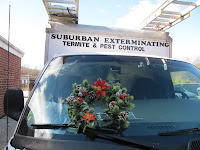2010 news headlines say it all with “Dorm rooms at Hofstra treated for bedbugs”, “Bedbugs Strike Second Abercrombie Store in Manhattan” and “Guest Says She Was Bitten by Bedbugs at Waldorf ” . Do we need to vote on the worst pest of 2010 or can we just declare bed bugs as the winner? Yes, bed bugs are the worst pests of 2010.
My Hopes for 2011 – OR - What will happen to bedbugs in 2011?
· I’ll stop itching at the mention of bed bugs.
· Once again, I’ll feel that a hotel is a luxury, not a potential bed bug home.
· Let global warming continue. All stages of bed bugs are killed at temperatures over 120 degrees.
· Bed bugs will be confined to a small area on this earth. Maybe, a large bug jar can hold them all.
· Bed bugs will die when I wave a magic wand. Does anyone have a magic wand?
Here are some basic bed bug facts.
How do you identify bed bugs?
Bedbugs are flat, reddish-brown, oval insects about the size of an apple seed (3/16-inch long). They become swollen and redder after eating. The bedbug cannot fly but crawls or hitchhikes from place to place. Bedbugs leave clusters of dark brown or black spots of dried excrement on infested surfaces. Bedbugs also exude a subtle, sweet, musty odor. Females can lay 200 to 500 eggs in a lifetime. Under the best conditions, they can live over 300 days.
Bedbugs hide in cracks and crevices between mattress and box springs, headboards, suitcases, sheets, baseboards, furniture, almost anywhere. Bedbugs love a messy room or a hospital room. People usually “discover” bedbugs after they have been bitten. Bedbugs like to feed around 4:00 am and are attracted to people by their breathing. The bedbug bite wound may be a raised bump with minor swelling followed by itching. Commonly, skin reactions to bedbug bites may not show up for 1-2 weeks after the bite. Bedbugs are not known to spread disease.
Suburban Exterminating can perform a free inspection to identify your pest.
How do you get rid of bed bugs?
Bedbugs are very difficult to control. Since they can hide in so many places, treatments must be complete. The best plan is to hire the services of a professional. Experienced pest control firms know where to look for bedbugs, and have an assortment of management tools at their disposal. Strategies of inspection, preparation and treatment can eliminate bedbugs from even the worst infestations.
Owners and occupants have an important role and will need to assist the professional exterminator. Clutter and belongings hide bedbugs and prevent complete treatment. Since bedbugs can move throughout a building, it often will be necessary to inspect adjoining rooms and apartments.
Let Suburban Exterminating be your professional bed bug killer.




